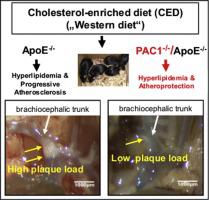Immunobiology ( IF 2.5 ) Pub Date : 2020-02-29 , DOI: 10.1016/j.imbio.2020.151930 Paul Splitthoff 1 , Erik Rasbach 1 , Philip Neudert 1 , Gabriel A Bonaterra 1 , Anja Schwarz 1 , Lilli Mey 1 , Hans Schwarzbach 1 , Lee E Eiden 2 , Eberhard Weihe 1 , Ralf Kinscherf 1

|
The neuropeptide, pituitary adenylate cyclase-activating polypeptide (PACAP) is vasoactive and cytoprotective and exerts immunoregulatory functions throughout the nervous, neuroendocrine cardiovascular and immune systems in health and disease. PACAP mainly acts through PAC1 receptor signaling in neuronal communication, but the role of PAC1 in immune regulation of atherosclerosis is not known. Here, we generated PAC1−/−/ApoE−/− mice to test, whether PAC1−/− influences plasma cholesterol-/triglyceride levels and/or atherogenesis in the brachiocephalic trunk (BT) seen in ApoE−/− mice, under standard chow (SC) or cholesterol-enriched diet (CED). Furthermore, the effect of PAC1−/−, on inflammatory, autophagy-, apoptosis- and necroptosis-relevant proteins in atherosclerotic plaques was determined. In plaques of PAC1−/−/ApoE−/− mice fed a SC, the immunoreactivity for apoptotic, autophagic, necroptotic and proinflammatory proteins was increased, however, proliferation was unaffected. Interestingly, without affecting hyperlipidemia, PAC1−/− in ApoE−/− mice remarkably reduced CED-induced lumen stenosis seen in ApoE−/− mice. Thus, PAC1−/− allows unchecked inflammation, necroptosis and decreased proliferation during SC, apparently priming the BT to develop reduced atheroma under subsequent CED. Remarkably, no differences in inflammation/necroptosis signatures in the atheroma under CED between PAC1−/−/ApoE−/− and ApoE−/− mice were observed. These data indicate that selective PAC1 antagonists should offer potential as a novel class of atheroprotective therapeutics, especially during hypercholesterolemia.
中文翻译:

PAC1 缺陷减弱了富含胆固醇饮食下 ApoE 缺陷小鼠的动脉粥样硬化进展。
神经肽、垂体腺苷酸环化酶激活多肽 (PACAP) 具有血管活性和细胞保护作用,并在健康和疾病的整个神经、神经内分泌心血管和免疫系统中发挥免疫调节功能。PACAP 主要通过神经元通讯中的 PAC1 受体信号传导发挥作用,但 PAC1 在动脉粥样硬化免疫调节中的作用尚不清楚。在这里,我们生成了 PAC1 -/- /ApoE -/-小鼠来测试 PAC1 -/-是否影响血浆胆固醇/甘油三酯水平和/或 ApoE -/-小鼠头臂干 (BT) 中的动脉粥样硬化,在标准条件下食物 (SC) 或富含胆固醇的饮食 (CED)。此外,PAC1 的作用-/-, 测定了动脉粥样硬化斑块中与炎症、自噬、细胞凋亡和坏死相关的蛋白质。在喂食 SC 的 PAC1 -/- /ApoE -/-小鼠斑块中,凋亡、自噬、坏死和促炎蛋白的免疫反应性增加,但增殖不受影响。有趣的是,在不影响高脂血症的情况下, ApoE -/- 小鼠中的PAC1 -/-显着减少了在 ApoE -/-小鼠中观察到的 CED 诱导的管腔狭窄。因此,PAC1 -/-允许在 SC 期间不受控制的炎症、坏死和增殖减少,显然引发 BT 在随后的 CED 下发展减少的动脉粥样硬化。值得注意的是,在 CED 下,PAC1 -/- /ApoE -/-和 ApoE -/-小鼠之间的粥样斑块中没有观察到炎症/坏死性凋亡特征的差异。这些数据表明,选择性 PAC1 拮抗剂应该具有作为一类新的动脉粥样硬化保护疗法的潜力,尤其是在高胆固醇血症期间。











































 京公网安备 11010802027423号
京公网安备 11010802027423号